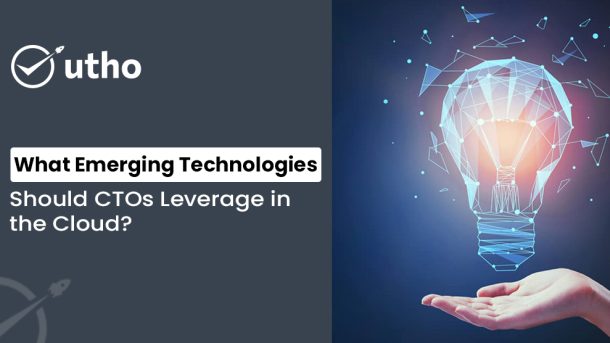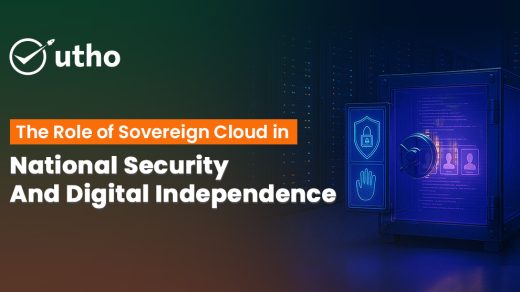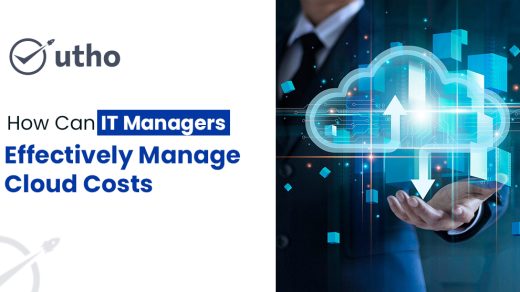Introduction to Emerging Cloud Technologies
In today's fast-paced digital world, CTOs shape their firms' tech strategies. Cloud computing has grown fast. It is now the basis for innovation, scalability, and efficiency. As businesses shift to the cloud, CTOs must stay ahead. They should use the latest cloud technologies to stay competitive.
Cloud technologies are evolving quickly. They help businesses improve infrastructure, streamline processes, enhance security, and boost agility. This blog covers some promising new cloud technologies. CTOs should consider them to drive digital transformation and future-proof their organizations.
Why Should CTOs Leverage Emerging Cloud Technologies?
CTOs must balance innovation with cost-effective, practical solutions. They must ensure business continuity and scalability. Why should CTOs embrace emerging cloud technologies? The answer lies in the immense benefits these technologies offer, such as:
- Competitive Advantage: Adopting the latest cloud tech lets firms outpace rivals. It helps them to provide excellent services, improve customer experiences, and speed up time to market.
- Agility and Flexibility: Cloud tech lets businesses quickly adapt to market changes. They can scale infrastructure as needed and deploy new apps fast.
- Cost Efficiency: New cloud technologies often manage resources better. They reduce costs by automating processes and optimizing infrastructure.
- Improved Security: Advanced cloud security solutions protect sensitive data. They ensure compliance with evolving regulations, which is vital as cyber threats grow.
Innovation and Digital Transformation: Emerging cloud technologies drive digital transformation. They help organizations integrate AI and other
advanced tools into their processes. This fosters a culture of innovation.
1. Artificial Intelligence and Machine Learning in the Cloud
A major advance in Cloud Technologies is integrating AI and ML into cloud platforms. AI and ML are transforming industries. They let businesses use data for predictive analytics, automation, and better decision-making.
How AI and ML Benefit Cloud Technologies:
- AI and ML algorithms can process huge amounts of data in real-time. This helps businesses gain insights and make data-driven decisions.
- Automation: AI tools cut manual tasks, boost efficiency, and reduce errors.
- Predictive Analytics: Cloud AI and ML let businesses forecast trends and demand. This helps them stay ahead of the competition.
- Personalization: AI and ML let businesses personalize user experiences. They do this by analyzing customer preferences and behavior.
CTOs should explore cloud platforms with integrated AI and ML services. Examples are AWS SageMaker, Google Cloud AI, and Azure AI. They can help unlock data-driven innovation.
2. Serverless Computing
Serverless computing is a new trend in Cloud Technologies. It lets developers build and deploy apps without managing the underlying infrastructure. In a serverless model, cloud providers manage the resources to run the app. This lets developers focus on writing code.
Benefits of Serverless Computing:
- Cost Efficiency: With serverless computing, businesses pay only for their apps' execution time. This eliminates idle server costs.
- Scalability: Serverless apps scale automatically with demand. This helps handle traffic and resource changes.
- Reduced Operational Overhead: Serverless computing shifts infrastructure management to the cloud provider. This includes provisioning, scaling, and maintenance.
Popular serverless services include AWS Lambda, Azure Functions, and Google Cloud Functions. CTOs can use these technologies to speed up development. They can also reduce complexity and cut costs.
3. Edge Computing
As IoT devices and connected systems create more data, Edge Computing is emerging as a powerful cloud technology. Edge computing means processing data closer to the source. This is often IoT devices or local servers. It is better than sending it to a centralized cloud server for processing.
Why Edge Computing is Vital for Cloud Technologies:
- Low Latency: Processing data at the edge cuts cloud data transfer time. This results in faster response times.
- Bandwidth Optimization: Edge computing cuts the data sent to the cloud. This saves bandwidth and lowers data transfer costs.
- Edge computing lets industries, like autonomous vehicles and healthcare, process data instantly. It enables real-time analytics by avoiding cloud delays.
CTOs should integrate edge computing with their cloud infrastructure. This will help handle the rising demands of IoT devices, reduce latency, and improve real-time data processing.
4. Hybrid Cloud and Multi-Cloud Strategies
As businesses grow, their IT needs become complex. They often require a mix of on-premise, public cloud, and private cloud solutions. This has led to Hybrid Cloud and Multi-Cloud strategies. They let businesses run workloads across multiple clouds. This boosts flexibility, control, and resilience.
Advantages of Hybrid Cloud and Multi-Cloud Strategies:
- Flexibility: A hybrid cloud lets businesses keep sensitive workloads on-premise. They can use the public cloud's scalability for less critical tasks.
- Cost Optimization: By choosing the cheapest cloud environments for specific workloads, businesses can cut cloud costs.
- Redundancy and Failover: Multi-cloud strategies use multiple cloud providers. This ensures business continuity if one provider fails.
Cloud platforms like AWS, Google Cloud, and Azure support hybrid and multi-cloud setups. CTOs should use these strategies. They will maximize flexibility, ensure data sovereignty, and reduce vendor lock-in.
5. Quantum Computing in the Cloud
Quantum Computing is still new. But, it will soon be a top Cloud Technology. It will transform many fields. Quantum computing can solve complex problems classical computers can't. These include optimizing supply chains, advancing drug discovery, and improving cryptography.
Key Benefits of Quantum Computing:
Quantum computing can analyze data at a scale that classical computers cannot. It can enable breakthroughs in materials science and AI.
- Enhanced Security: Quantum encryption may revolutionize cybersecurity. It promises unmatched data protection in the cloud.
- Quantum computing can speed up research in genomics, drug discovery, and climate modeling. This will greatly improve healthcare and the environment.
CTOs should watch quantum computing services from cloud providers, like IBM Quantum, AWS Braket, and Google Quantum AI. They should explore potential use cases as this technology matures.
6. Cloud-Native DevOps
Cloud-Native tech is speeding up software delivery. It's also making operations more efficient. DevOps practices are evolving to keep up. Cloud-native DevOps leverages containerization, microservices, and CI/CD automation to build, deploy, and scale applications in the cloud seamlessly.
Benefits of Cloud-Native DevOps in Cloud Technologies:
- Containerization: Tools like Docker create consistent environments. They work across development, testing, and production. This makes it easier to deploy apps in the cloud.
- Microservices Architecture: Microservices split apps into smaller, independent services. They can be deployed and scaled independently. This improves agility and reduces complexity.
- CI/CD: Automating the build, test, and deployment processes. It ensures faster releases, higher quality software, and fewer errors.
CTOs should focus on cloud-native DevOps. It will optimize their software development, improve scalability, and boost innovation in the cloud.
7. Blockchain Technology
Blockchain is best known for its use in cryptocurrency. It has broader applications, making it an emerging player in Cloud Technologies. Blockchain offers a secure, decentralized way to record transactions and manage data. It's ideal for finance, supply chain, and healthcare. They need transparency and immutability.
How Blockchain Enhances Cloud Technologies:
- Security: Blockchain's decentralized ledger makes data tamper-proof and secure. It's an excellent option for storing and transacting sensitive data.
- Transparency: Blockchain ensures all parties have the same information. It provides a single source of truth, which allows for greater transparency.
- Smart Contracts: These self-executing contracts enforce their code. They cut out middlemen and boost efficiency.
CTOs should explore blockchain in cloud environments. It can enhance security, improve transparency, and streamline operations. This is crucial for sectors that handle sensitive or high-value data.
8. Cloud Security Solutions
As the adoption of cloud services grows, so does the need for robust Cloud Security solutions. Cloud security is now essential. It protects data, apps, and systems from cyber threats.
Emerging Cloud Security Technologies:
- Zero Trust Security: Zero trust is a security model. It assumes no entity, inside or outside the network, can be trusted by default. It needs to verify every user or device trying to access cloud resources.
- AI-Powered Security: AI and ML detect threats and anomalies. They automate real-time responses to security incidents. This enhances cloud security.
- Data Encryption and Tokenization: They protect sensitive data at rest, in transit, and in use. They prevent unauthorized access to critical information.
CTOs should prioritize cloud security. It will protect their data and ensure compliance with GDPR, HIPAA, and CCPA.
Conclusion
Cloud Technologies are evolving quickly. This gives CTOs a chance to innovate and optimize their organizations. They can also future-proof them. Many new technologies can change how businesses operate in the cloud. They include AI, machine learning, quantum computing, serverless computing, and cloud-native DevOps. CTOs must stay informed about these advancements. They must adopt the technologies that best align with their business goals and IT needs.
With the right cloud tech, CTOs can drive digital change. They can boost efficiency, security, and create a more agile, resilient organization for the future.
Utho, an open-source inspired platform, is at the forefront of cloud innovation. Utho's flexible, low-cost solutions help businesses use new cloud tech. This lets them innovate while keeping control of their infrastructure.




